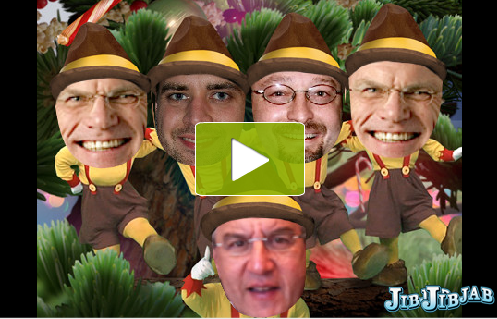innovation DAILY
Here we highlight selected innovation related articles from around the world on a daily basis. These articles related to innovation and funding for innovative companies, and best practices for innovation based economic development.
The Top 10 'Top 10' Lists Of 2010
 With so many lists to choose from, how can you choose which list to choose from?
With so many lists to choose from, how can you choose which list to choose from?
We've done the work for you. Here is our highly meta list of the top ten Top Ten lists from 2010.
Pruning rotten apples from your company
The Osmond Brothers got it wrong. One bad apple CAN spoil the whole darn bunch. And that’s especially true in the startup world. A negative and selfish employee can start a contagion throughout the company, causing other employees to act the same way and sucking up more of management’s time, says Stanford Professor and author Bob Sutton in this entrepreneur thought leader lecture given at Stanford University. Reforming those bad apples is possible, but there comes a point where you have to cut your losses.
World's Largest Neutrino Detector Completed at South Pole
 Thousands of meters below the ice near the South Pole lies one of the most unusual observatories ever constructed. The instrument's nervous system comprises 86 strands of light detectors, stretching down into the ice sheet like oversize strings of pearls. Each strand features 60 basketball-size detectors, spanning the depths from 1,450 to 2,450 meters below the surface. And the body of the observatory is the ice itself, an abundant medium with an astonishing natural clarity.
Thousands of meters below the ice near the South Pole lies one of the most unusual observatories ever constructed. The instrument's nervous system comprises 86 strands of light detectors, stretching down into the ice sheet like oversize strings of pearls. Each strand features 60 basketball-size detectors, spanning the depths from 1,450 to 2,450 meters below the surface. And the body of the observatory is the ice itself, an abundant medium with an astonishing natural clarity.
Altogether, the instrument, known as IceCube, spans a cubic kilometer of ice. Scientists have for years been taking data using the partially built observatory, but on December 18 the 86th and final string of detectors was lowered into place, marking the completion of construction on the estimated $270-million project. The observatory will likely start running at full strength in April, according to communications manager Laurel Bacqué.
Brazil's richest man: the possibilities for Rio's transformation are limitless
 He extracted his first million from lawless goldmines deep in the Amazon jungle and went on to become Brazil's richest man, a smooth-talking mining and energy tycoon who keeps a Mercedes-Benz SLR in his sitting room as a symbol of his $27bn (£17bn) empire.
He extracted his first million from lawless goldmines deep in the Amazon jungle and went on to become Brazil's richest man, a smooth-talking mining and energy tycoon who keeps a Mercedes-Benz SLR in his sitting room as a symbol of his $27bn (£17bn) empire.
Now, with Rio de Janeiro gearing up for the 2014 World Cup and 2016 Olympics, Brazilian entrepreneur Eike Batista has set himself two new goals: to help transform his adoptive beachside home into one of the world's most dynamic and affluent cities, and to become the richest man on Earth.
"Mister Carlos Slim has to invent a new race kart to catch up," said the 53-year-old, referring to the Mexican telecoms billionaire rated by Forbes as the world's wealthiest person. Batista is currently eighth.
An Innovation Agenda for the 112th Congress
 For too long Congress has approached innovation policy in a fragmented and uncoordinated way. The result is that other countries are beginning to erode America’s standing as the global innovation leader. In fact, the National Academy of Sciences recently warned Congress that other countries have copied America’s innovation playbook and are aggressively implementing pro-growth policies at a rapid pace.
For too long Congress has approached innovation policy in a fragmented and uncoordinated way. The result is that other countries are beginning to erode America’s standing as the global innovation leader. In fact, the National Academy of Sciences recently warned Congress that other countries have copied America’s innovation playbook and are aggressively implementing pro-growth policies at a rapid pace.
As the 112th Congress begins its transition, it has the opportunity to refocus its attention on consensus-building, job-creating policies that can accelerate innovation. To assist Congress in this endeavor, CONNECT submits a multi-faceted Innovation Agenda.
Download the PDF
Greetings From Recoveryland: Ten Places to Watch Coming Out of the Recession
 Like a massive tornado, the Great Recession up-ended the topography of America. But even as vast parts of the country were laid low, some cities withstood the storm and could emerge even stronger and shinier than before. So, where exactly are these Oz-like destinations along the road to recovery? If you said Kansas, you’re not far off. Try Oklahoma. Or Texas. Or Iowa. Not only did the economic twister of the last two years largely spare Tornado Alley, it actually may have helped improve the landscape.
Like a massive tornado, the Great Recession up-ended the topography of America. But even as vast parts of the country were laid low, some cities withstood the storm and could emerge even stronger and shinier than before. So, where exactly are these Oz-like destinations along the road to recovery? If you said Kansas, you’re not far off. Try Oklahoma. Or Texas. Or Iowa. Not only did the economic twister of the last two years largely spare Tornado Alley, it actually may have helped improve the landscape.
We have compiled a list of the 10 American cities best situated for the recovery. These are places where the jobs are plentiful, and the pay, given the lower cost of living, buys more than in bigger cities. In other words, places unlike much of the rest of the country. The cities, most of which lie in the red-state territory of America’s heartland, fall into three basic groups. There’s the Texaplex—Austin, Dallas, San Antonio, and Houston—which has become the No. 1 destination for job-seeking Americans, thanks to a hearty energy sector and a strong spirit of entrepreneurism. There are the New Silicon Valleys—Raleigh-Durham, N.C.; Salt Lake City; and urban northern Virginia—which offer high-paying high-tech jobs and housing prices well below those in coastal California. And then there are the Heartland Honeys—Oklahoma City, Indianapolis, and Des Moines, Iowa—which are enjoying a revival thanks to rising agricultural prices and a shift toward high-end industrial jobs.
Foursquare Founder Dennis Crowley's Top 6 Pieces Of Advice For Entrepreneurs
 Dennis Crowley, who has appeared on multiple magazine covers this year and was on Fox News just this afternoon, is the entrepreneur of the moment.
Dennis Crowley, who has appeared on multiple magazine covers this year and was on Fox News just this afternoon, is the entrepreneur of the moment.
He is the founder of Foursquare, and he left entrepreneurs with some words of wisdom on question and answer site, Quora.
Read on for Crowley's full answer.
12 Things You Probably Didn't Know About Christmas
 As the Christmas season is fast approaching, I thought it might be interesting to delve into the history of the holidays. It turns out that there are many myths, false tales, and little known facts about the Christmas
As the Christmas season is fast approaching, I thought it might be interesting to delve into the history of the holidays. It turns out that there are many myths, false tales, and little known facts about the Christmas
holiday and I thought I would share some of these. I present to you 12 things you (probably) didn't know about Christmas, in no particular order.
1) The tradition of Santa being pulled by reindeer begain in the 19th century when a group of people moved from Norway to Alaska with a herd of reindeer, who were later used to pull sleds with Santa on them for an advertising campaign.
2) Rudolph the Red Nosed reindeer was invented in 1939 by a man working for a department store, previous to this there had only been 8 reindeer.
3) In North American tradition, Santa Claus lives at the North Pole. However, in Denmark folklore he lives on Greenland, and each country on the Scandinavian peninsula has an area in which he is told to reside.
4) The X in the abbreviation X-mas is derived from the Greek letter Chi which is the first letter of Christ's name in the Greek alphabet, rather than an attempt to remove the religious aspect of the holiday as some believe.
5) Although the birth of Jesus is celebrated on Christmas, it is cloudy as to whether he was actually born on December the 25th or not. This date was chosen to give Christian meaning to existing pagan rituals.
5 Gallon Water Bottle Christmas Tree

5 Gallon Water Bottle Christmas Tree
All Successful Innovation Needs a Champion and Ownership
 This is the forth part in a series of articles that take the need of innovation under the loop and share some of the imperatives, must haves if you will, to create and sustain “NEW” in business or organizations. This article focuses on the need for ownership, as all successful innovations need a champion within the organization. See the full article in InnovationManagement here.
This is the forth part in a series of articles that take the need of innovation under the loop and share some of the imperatives, must haves if you will, to create and sustain “NEW” in business or organizations. This article focuses on the need for ownership, as all successful innovations need a champion within the organization. See the full article in InnovationManagement here.
Innovation needs ownership, a champion within the organization. The champion must convince others to take calculated risks and work a bit - all right, sometimes a lot - outside of one’s comfort zone.
Often the most successful product development managers are the most facile, accomplished and successful salespeople within the company. Why? Because, as the leader, sometimes you have to be able to build consensus around a new, untested idea and have a disparate group of people, who typically are highly resistant to change, rally for a cause with an uncertain outcome.
VC Outlook: Noah Walley Eager For 2011 To Be Free Of Bubbles, Busts
 As 2010 comes to a close, we asked several venture capital investors to reflect on the past year and give us their outlook for 2011. We’ll be bringing you their responses over the coming days.
As 2010 comes to a close, we asked several venture capital investors to reflect on the past year and give us their outlook for 2011. We’ll be bringing you their responses over the coming days.
Next up in the series is Noah Walley, managing director at Investor Growth Capital. Walley, who focuses on software and technology-based services investments, thinks 2010 was better than 2009 - though that’s not saying much - but that the IPO market needs to rebound significantly.
Wright's Falling Water in gingerbread

As part of the Internet's ongoing effort to recreate Frank Lloyd Wright's famous Falling Water house in as many media as possible (Lego, Half Life 2), the folks at Garden Melodies have produced a gingerbread edition:
It took over 12 hours to design
It took Brenton and I around 40 hours to build and decorate
There are around 164 different pieces of gingerbread
It took roughly 12 square feet of gingerbread dough (that's four large batches) to make all the walls, floors and roof
Over 8 bags of powdered sugar were used to make all the frosting
It took over 40 sleeves of large Smarties which are used to simulate dry stack stone on the building exterior
The river and water fall are made up of three batches of hard candy
Whose Life are You Going to Change?
 Many of us have the ability to change the trajectory of other people’s lives. Sometimes we don’t even realize it. This is a story of one person who had the power to change my life – and did so. It’s the story of persistence in entrepreneurs. And it’s the story of “paying it forward.”
Many of us have the ability to change the trajectory of other people’s lives. Sometimes we don’t even realize it. This is a story of one person who had the power to change my life – and did so. It’s the story of persistence in entrepreneurs. And it’s the story of “paying it forward.”
The person who changed my life was Cory Van Wolvelaere, who passed away two years ago this week after a long battle with cancer. I know his life touched many of us that worked with him – in ways he never knew. In his 53 years he changed the trajectory of lives including mine.
We all have the ability to change the trajectory of the lives of others. As a VC I’m acutely that a “yes” decision to support an entrepreneur can do just that, yet I only write 2-4 of them per year and maybe another 3-4 as an angel. But I strive to impact the lives of many more through hours of coaching entrepreneurs, challenging people to be better, making human connections for people or providing timely advice.
This Christmas Elf Flies Off The Shelf
 He’s been called charming. He’s been called creepy. He travels under cover of night, moving from perch to perch. And he knows if your kids have been naughty or nice.
He’s been called charming. He’s been called creepy. He travels under cover of night, moving from perch to perch. And he knows if your kids have been naughty or nice.
He’s the Elf on the Shelf. A book. A doll. And now a holiday phenomenon at a home near you. Maybe even yours.
According to a story in USA Today, the 8-inch-tall fella spends his days “watching” kids to see if they’re behaving. Then he flies to the North Pole to report bad behavior to Santa, nightly trips that kids are well aware of. When he returns, he lands in a different spot in the house, thanks to a parent’s helping hand, setting off a hide-and-seek game every morning.
To Run a Startup, You Must Stay in High Learn Mode
 Being an entrepreneur these days requires an understanding of a thousand topics, many of which don’t even exist today in traditional learning vehicles, like schools and textbooks. The Internet and its information wave have changed everything – it’s the problem, with constant change, and it’s the solution, if you use it to navigate quickly and self-educate.
Being an entrepreneur these days requires an understanding of a thousand topics, many of which don’t even exist today in traditional learning vehicles, like schools and textbooks. The Internet and its information wave have changed everything – it’s the problem, with constant change, and it’s the solution, if you use it to navigate quickly and self-educate.
True entrepreneurs love to learn, unlearn, and relearn, whether they are 20 years old, or 60 years old. A new business means change, so they deal in change, and relish the journey. Usually it’s called initiative, dedication, and can-do attitude.
But under these words are some common principles that every entrepreneur needs to follow implicitly or explicitly, to keep up with change, and actually make change:
- Stay open to learning. Unlearning and relearning doesn’t require that you toss out any of your accumulated experiences or know-how. It just requires a relentless focus and willingness to do better things, and accept better ways of getting things done.
How “Investor Preference” Will Help You Attract Funding
 “Back in the day” (late 1999) I was a part of an investor group that contributed $1 million for a 35 percent ownership stake in a startup technology venture that held a lot of promise (don’t they all?). You can probably guess the next chapter in this story. The tech bubble burst, the NASDAQ dropped 65 percent, technology needs shifted quickly and our company’s outlook changed dramatically within about a year.
“Back in the day” (late 1999) I was a part of an investor group that contributed $1 million for a 35 percent ownership stake in a startup technology venture that held a lot of promise (don’t they all?). You can probably guess the next chapter in this story. The tech bubble burst, the NASDAQ dropped 65 percent, technology needs shifted quickly and our company’s outlook changed dramatically within about a year.
Fortunately, we had a great investment banker who was able to arrange a sale of the company and its technology to a public company out of Canada for $1.5 million USD. Our 35 percent equity stake in the company would return only $525,000 of our initial investment, a 50 percent haircut in less than 18 months. Ouch!

 The world's coolest malls are much more than places to go shopping.
The world's coolest malls are much more than places to go shopping.

